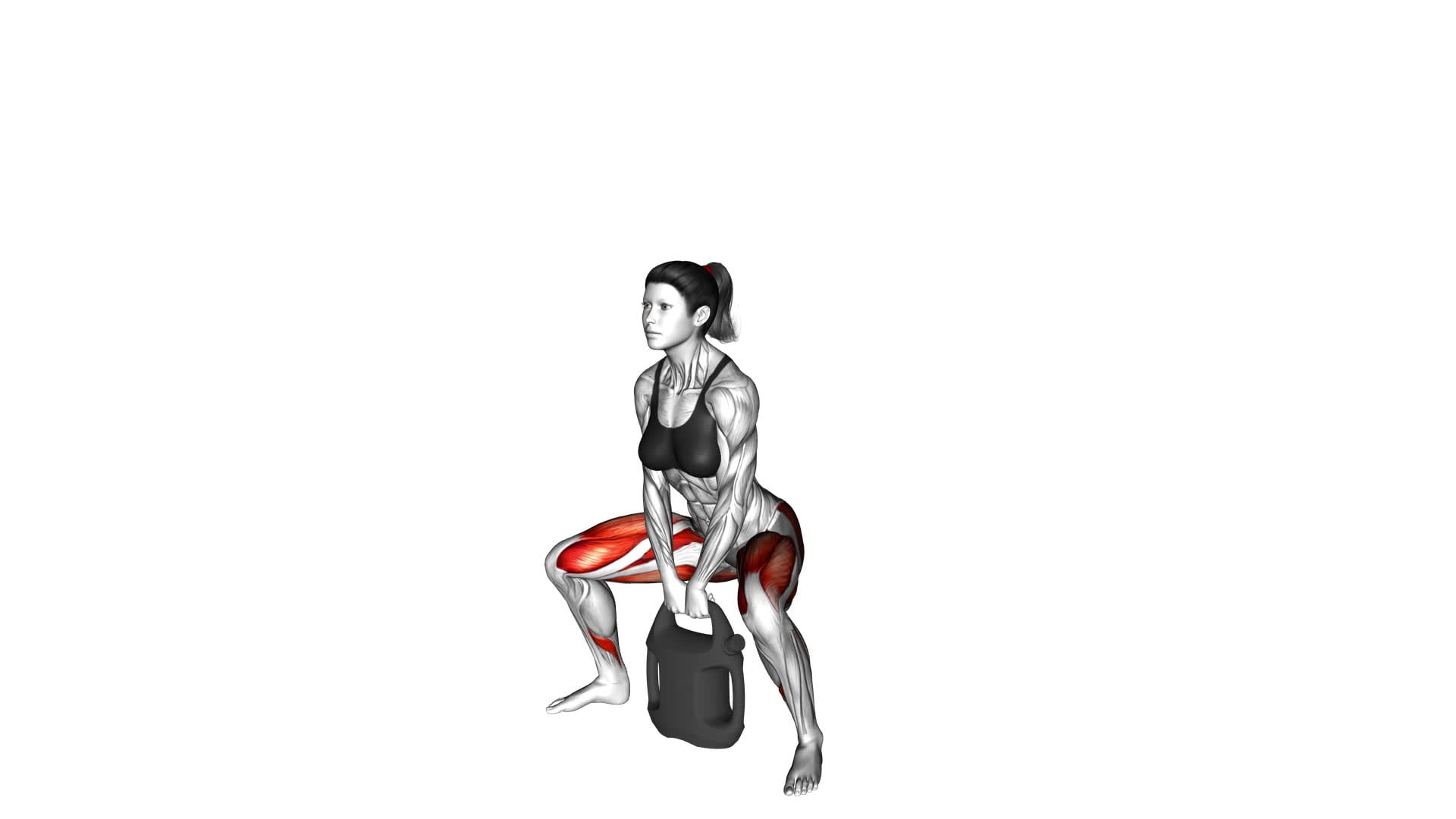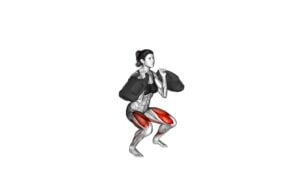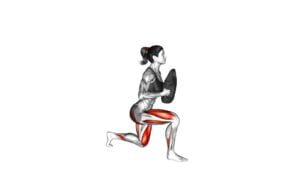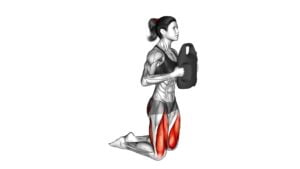Bottle Weighted Sumo Squat (female) – Video Exercise Guide & Tips

Are you looking for a challenging lower body exercise that targets your glutes and thighs? Look no further than the bottle weighted sumo squat!
Watch This Exercise Video
This exercise guide and video will show you the proper technique and provide helpful tips to get the most out of your workout. Whether you're a beginner or more advanced, this variation of the sumo squat is sure to challenge and strengthen your lower body.
Get ready to feel the burn!
Key Takeaways
- Bottle weighted sumo squats provide increased resistance for greater muscle strength and endurance.
- This exercise specifically targets the inner thighs and adductors for a well-rounded lower body workout.
- Engaging in bottle weighted sumo squats improves overall functional strength for daily tasks and helps prevent injuries.
- It also engages core muscles for improved stability and balance, while providing added intensity for building strength and muscle.
Benefits of Bottle Weighted Sumo Squat
You can experience numerous benefits by incorporating bottle weighted sumo squats into your workout routine. One of the main benefits is the added resistance that the bottle provides. By adding weight to your squats, you increase the intensity of the exercise, which can lead to greater muscle strength and endurance. This is especially beneficial if you're looking to build lower body strength and tone your legs and glutes.
Another advantage of bottle weighted sumo squats is that they offer an alternative variation to the traditional squat. While regular squats primarily target the quadriceps and glutes, sumo squats place more emphasis on the inner thighs and adductors. This variation helps to engage different muscles and can provide a more well-rounded lower body workout.
Additionally, incorporating bottle weighted sumo squats into your routine can improve your overall functional strength. Squatting is a fundamental movement pattern that mimics everyday activities such as sitting down and standing up. By strengthening the muscles involved in this movement, you can enhance your performance in daily tasks and reduce the risk of injury.
Proper Technique for Bottle Weighted Sumo Squat
To perform the bottle weighted sumo squat properly, follow these steps:
- Stand with your feet wider than shoulder-width apart, toes pointed outwards.
- Hold a bottle in each hand, with your arms extended down in front of you.
- Engage your core and keep your chest lifted throughout the exercise.
- Bend your knees and lower your hips down towards the ground, as if you were sitting back into a chair.
- Make sure your knees are tracking over your toes and your weight is evenly distributed between your heels and the balls of your feet.
- Go as low as you comfortably can, aiming to have your thighs parallel to the ground.
- Pause for a moment at the bottom of the squat, then push through your heels to stand back up, squeezing your glutes at the top.
By following proper technique, you can reap the benefits of the bottle weighted sumo squat. This exercise targets your quadriceps, hamstrings, glutes, and calves, helping to strengthen and tone your lower body. It also engages your core, improving stability and balance. Additionally, the added resistance provided by the bottles increases the intensity of the exercise, making it a great option for building strength and muscle.
Now that you know the proper technique, let's move on to choosing the right bottle for weighted squats.
Choosing the Right Bottle for Weighted Squats
When choosing the right bottle for weighted squats, there are a few key considerations to keep in mind.
First, think about the size of the bottle you'll be using, as this will determine the weight you're adding to your squats.
Additionally, consider the distribution of weight within the bottle, as this can affect the stability and balance of your squats.
Bottle Size Considerations
Consider the appropriate bottle size for weighted squats by selecting one that suits your strength and fitness level. When choosing a bottle for weighted squats, you have several bottle size options to consider. Here are a few alternatives weight options you may want to explore:
- Small water bottles: These are lightweight and perfect for beginners or those with limited strength.
- Medium-sized bottles: These provide a bit more resistance and are suitable for individuals with moderate strength.
- Large bottles: If you have advanced strength, you can opt for larger bottles that offer more weight for a challenging workout.
By selecting the right bottle size, you can ensure that your weighted squats are effective and safe.
Transitioning into the next section about weight distribution options, let's now explore how to evenly distribute the weight in your chosen bottle.
Weight Distribution Options
Choose the appropriate bottle weight for your weighted squats by considering different weight distribution options.
When performing weighted squats with a bottle, it's crucial to distribute the weight evenly to maintain proper form and avoid injury.
One weight distribution technique is to fill the bottle partially with sand or water, allowing for adjustable weight. This option lets you increase or decrease the weight as needed, making it suitable for beginners or those looking to challenge themselves.
Another alternative is to use multiple bottles of the same weight, holding one in each hand to evenly distribute the load.
If you don't have bottles available, you can explore alternative equipment options such as dumbbells, kettlebells, or weighted vests. These options offer more stability and control over weight distribution.
Consider your preferences and available resources to choose the best weight distribution technique for your weighted squats.
Now, let's move on to the next section and discuss safety precautions to consider.
Safety Precautions to Consider
To ensure your safety while performing weighted squats, it's important to select the appropriate bottle for your workout. Here are some safety precautions to consider when choosing the right bottle for weighted squats:
- Size and weight: Choose a bottle that's comfortable for you to hold and lift, ensuring that it isn't too heavy or too light for your strength level.
- Durability: Opt for a sturdy bottle that can withstand the weight and movements involved in weighted squats, preventing any potential injuries.
- Grip and texture: Look for a bottle with a non-slip grip or textured surface to ensure a secure hold during the exercise, reducing the risk of accidents.
Remember, before starting any weighted squat routine, it's essential to warm up your muscles properly with dynamic stretches and light cardio exercises. This will help prevent injuries and prepare your body for the workout ahead.
Stay safe and enjoy your weighted squat session!
Common Mistakes to Avoid During Bottle Weighted Sumo Squat
When performing the bottle weighted sumo squat, it's important to focus on maintaining proper form. This means keeping your back straight, chest lifted, and knees aligned with your toes.
Additionally, pay attention to the distribution of weight between your heels and toes to avoid straining your knees.
Proper Form Importance
Maintain proper form to maximize the benefits and avoid common mistakes during the Bottle Weighted Sumo Squat. Proper technique is crucial for this exercise to be effective and safe. Here are the key reasons why proper form is important and the benefits it brings:
- Injury prevention: Performing the Bottle Weighted Sumo Squat with proper form reduces the risk of strain or injury to your muscles, joints, and ligaments.
- Muscle activation: Maintaining proper form ensures that the targeted muscles, such as the glutes, hamstrings, and quadriceps, are properly engaged throughout the movement.
- Efficient workout: By using correct form, you optimize the effectiveness of the exercise, allowing you to get the most out of each squat.
Weight Distribution Tips
Focus on distributing your weight evenly between both feet to maintain stability and prevent imbalance during the Bottle Weighted Sumo Squat. Proper weight distribution techniques are crucial for performing this exercise effectively and safely. By evenly distributing your weight, you engage both the inner and outer thigh muscles, as well as the glutes. This helps to increase overall lower body strength and stability.
When performing weighted squats, the added resistance from the bottle helps to further challenge your muscles, leading to greater strength gains. By distributing the weight evenly, you can ensure that both legs are working equally, reducing the risk of muscle imbalances and potential injury.
Now, let's move on to the next section about avoiding knee strain.
Avoiding Knee Strain
To avoid knee strain during the Bottle Weighted Sumo Squat, make sure you distribute your weight evenly and maintain proper form throughout the exercise. Here are some tips to prevent injuries and modify the exercise if needed:
- Start with lighter weights: If you're new to this exercise or have knee issues, it's advisable to start with lighter bottles or no weights at all.
- Keep your knees aligned: Ensure that your knees are in line with your toes throughout the movement. Avoid letting them collapse inward, as this can strain the knee joint.
- Modify the depth: If you experience discomfort in your knees, you can modify the squat by not going as low. Instead, focus on maintaining proper form and gradually increasing the depth as you gain strength.
Variations and Progressions of Bottle Weighted Sumo Squat
You can gradually increase the weight of the bottle as you regularly perform the Bottle Weighted Sumo Squat exercise. This will allow you to challenge your muscles and continue progressing in your fitness journey.
There are also variations and modifications you can incorporate into your routine to target different muscle groups and add variety to your workouts.
One variation is the Single Leg Sumo Squat. Instead of using both legs, you'll perform the squat on one leg at a time. This variation places more emphasis on the glutes and inner thighs, helping to strengthen and tone those areas.
Another variation is the Pulse Squat. Instead of coming all the way up after each squat, you'll stay in a lowered position and perform small pulses up and down. This variation increases the time under tension for your muscles, making the exercise more challenging.
While the Bottle Weighted Sumo Squat has many benefits, it also has a few drawbacks. One drawback is that the weight of the bottle may not be challenging enough for those who are more advanced in their fitness level. In this case, using a heavier weight such as dumbbells or a barbell can provide a greater challenge. Additionally, it's important to maintain proper form throughout the exercise to avoid any potential strain on the knees or lower back.
Incorporating variations and modifications into your Bottle Weighted Sumo Squat routine can help keep your workouts interesting and target different muscle groups. However, it's important to listen to your body and choose variations that are appropriate for your fitness level and goals.
Tips for Getting the Most Out of Bottle Weighted Sumo Squat
To maximize your results with the Bottle Weighted Sumo Squat, make sure to maintain proper form and engage your core throughout the exercise. Here are some tips to help you get the most out of this workout:
- Weight Selection: Choose a bottle with a weight that challenges you but allows you to maintain proper form. Start with a lighter weight and gradually increase as you get stronger.
- Breathing Techniques: Focus on your breathing during the exercise. Inhale as you lower your body into the squat position and exhale as you push through your heels to stand back up. This will help you maintain control and stability throughout the movement.
- Core Engagement: Keep your core muscles engaged throughout the exercise. This won't only help you maintain balance but also strengthen your core muscles. Imagine pulling your belly button towards your spine to activate your deep abdominal muscles.
By following these tips, you'll ensure that you're performing the Bottle Weighted Sumo Squat correctly and effectively. Remember to listen to your body and make adjustments as needed.
With time and consistency, you'll see improvements in your strength and overall fitness level.
Frequently Asked Questions
How Many Repetitions Should I Do When Performing the Bottle Weighted Sumo Squat?
When performing the bottle weighted sumo squat, it's important to focus on proper form and technique. To get the most out of this exercise, aim for a moderate number of repetitions, such as 10 to 15, depending on your fitness level.
Incorporating bottle weighted sumo squats into your workout routine can help strengthen your lower body, improve balance, and increase overall muscle tone.
Remember to start with a weight that challenges you but allows you to maintain proper form throughout each repetition.
Can Men Also Perform the Bottle Weighted Sumo Squat Exercise?
Yes, men can definitely perform the bottle weighted sumo squat exercise. It's a great lower body exercise that targets the quads, hamstrings, and glutes. By incorporating variations of sumo squats, you can add variety to your workout routine and challenge different muscle groups.
Whether you're a man or a woman, the bottle weighted sumo squat can be a beneficial addition to your fitness regimen. Remember to maintain proper form and gradually increase the weight as you progress.
Is It Necessary to Warm up Before Doing Bottle Weighted Sumo Squats?
Before performing bottle weighted sumo squats, it's important to warm up to prevent injury and enhance your performance. Incorporating warm-up exercises can help increase blood flow, improve flexibility, and prepare your muscles for the workout. Skipping this step may lead to muscle strains or pulls.
Additionally, it's crucial to avoid common mistakes such as rounding your back or letting your knees collapse inward during the exercise. Focus on maintaining proper form to maximize the benefits of this exercise.
How Much Weight Should I Start With When Using a Bottle for Weighted Squats?
To determine the starting weight for bottle squats, it's important to focus on proper form. Begin with a weight that challenges you, but still allows you to maintain proper technique.
Start with a lighter bottle and gradually increase the weight as you become more comfortable. Remember to keep your back straight, knees aligned with your toes, and engage your core muscles.
Starting with the right weight and maintaining proper form will help you maximize the benefits of bottle weighted sumo squats.
Can Bottle Weighted Sumo Squats Help in Strengthening the Core Muscles?
Bottle weighted sumo squats are an effective way to strengthen your core muscles. By adding weight with a bottle, you increase the challenge and engage your core even more. This exercise not only targets your lower body, but also helps improve overall strength and stability.
To progress and increase difficulty, you can gradually increase the weight of the bottle or try variations like pulsing at the bottom of the squat. Keep challenging yourself to see maximum results.
Conclusion
In conclusion, the bottle weighted sumo squat is a beneficial exercise that can be easily incorporated into your fitness routine. By using a bottle as a weight, you can increase the intensity of your squats and target your lower body muscles effectively.
It's important to maintain proper technique and choose the right bottle weight to avoid any injuries. By avoiding common mistakes and exploring variations, you can maximize the benefits of this exercise.
Remember to always consult with a professional trainer for personalized guidance.

Author
Years ago, the spark of my life’s passion ignited in my mind the moment I stepped into the local gym for the first time. The inaugural bead of perspiration, the initial endeavor, the very first surge of endorphins, and a sense of pride that washed over me post-workout marked the beginning of my deep-seated interest in strength sports, fitness, and sports nutrition. This very curiosity blossomed rapidly into a profound fascination, propelling me to earn a Master’s degree in Physical Education from the Academy of Physical Education in Krakow, followed by a Sports Manager diploma from the Jagiellonian University. My journey of growth led me to gain more specialized qualifications, such as being a certified personal trainer with a focus on sports dietetics, a lifeguard, and an instructor for wellness and corrective gymnastics. Theoretical knowledge paired seamlessly with practical experience, reinforcing my belief that the transformation of individuals under my guidance was also a reflection of my personal growth. This belief holds true even today. Each day, I strive to push the boundaries and explore new realms. These realms gently elevate me to greater heights. The unique combination of passion for my field and the continuous quest for growth fuels my drive to break new ground.







